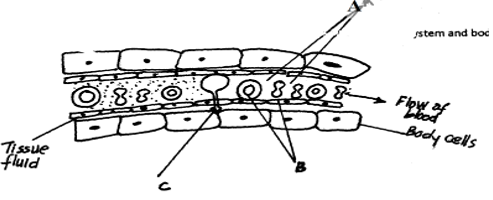Question
The diagram below shows the exchange site between circulatory system and body cells.

(a) State two adaptations of the capillaries.
(b)(i) Name the blood cells labeled B.
(ii) State the gas that diffuses from B to the tissue cells.
(c) State two functions of the part labeled A.

(a) State two adaptations of the capillaries.
(b)(i) Name the blood cells labeled B.
(ii) State the gas that diffuses from B to the tissue cells.
(c) State two functions of the part labeled A.
Answer
(a) Adaptations of capillaries.
(ii) Oxygen gas
(c) (i)
- Their walls are made up of an endothelium only which allows only part of the blood to move into the intercellular spaces
- They are numerous thus creating a large S.A for exchange of materials
- Have narrow lumen that maintains high blood pressure
- Have sphincter muscle at the arteriole end enabling regulation of blood flow
(ii) Oxygen gas
(c) (i)
- Transport of food nutrients
- Transport of metabolic wastes
- Transport of antibodies involved in defense against diseases

